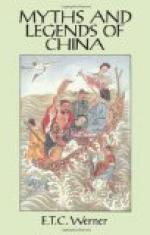Another account separates the name and makes Nue and Kua brother and sister, describing them as the only two human beings in existence. At the creation they were placed at the foot of the K’un-lun Mountains. Then they prayed, saying, “If thou, O God, hast sent us to be man and wife, the smoke of our sacrifice will stay in one place; but if not, it will be scattered.” The smoke remained stationary.
But though Nue Kua is said to have moulded the first man (or the first human beings) out of clay, it is to be noted that, being only the successor of Fu Hsi, long lines of rulers had preceded her of whom no account is given, and also that, as regards the heavens and the earth at least, she is regarded as the repairer and not the creator of them.
Heaven-deaf (T’ien-lung) and Earth-dumb (Ti-ya), the two attendants of Wen Ch’ang, the God of Literature (see following chapter), have also been drawn into the cosmogonical net. From their union came the heavens and the earth, mankind, and all living things.
These and other brief and unelaborated personal cosmogonies, even if not to be regarded as spurious imitations, certainly have not become established in the Chinese mind as the explanation of the way in which the universe came to be: in this sphere the P’an Ku legend reigns supreme; and, owing to its concrete, easily apprehensible nature, has probably done so ever since the time of its invention.
Early Cosmogony Dualistic
The period before the appearance of the P’an Ku myth may be divided into two parts; that from some early unknown date up to about the middle of the Confucian epoch, say 500 B.C., and that from 500 B.C. to A.D. 400. We know that during the latter period the minds of Chinese scholars were frequently occupied with speculations as to the origin of the universe. Before 500 B.C. we have no documentary remains telling us what the Chinese believed about the origin of things; but it is exceedingly unlikely that no theories or




